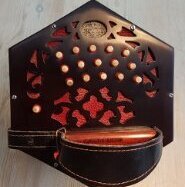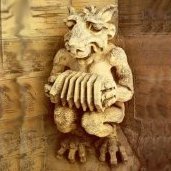-
Posts
1,864 -
Joined
-
Last visited
About Anglo-Irishman
- Birthday 06/15/1946
Contact Methods
-
AIM
johnedallas
-
Website URL
http://www.johndallas.de
-
ICQ
0
Profile Information
-
Gender
Male
-
Interests
Acoustic music of all kinds. Collecting playable instruments.
-
Location
Near Stuttgart, Germany
Recent Profile Visitors
Anglo-Irishman's Achievements

Heavyweight Boxer (5/6)
-
We might be onto something here ... 😉 John
-
I suppose something like a set of small pipes - the ones with a bag and a bellows ..
-

Concertina Sighting - SafetyWing Nomad Insurance
Anglo-Irishman replied to gcoover's topic in General Concertina Discussion
As I see it, the concertina is a German one. The handstraps are parallel to the adjacent sides of the hexagon, not perpendicular to them, as in English-made Anglos. Cheers, John -
Just a piece of info that might help you to get the Anglo into perspective with other instruments: Before I got my first Anglo, I'd had childhood piano lessons, and had been taught to play the mouth organ (AKA harmonica) by my Dad. When I bought the Anglo, together with the Tutor, which called it the "Anglo-Chromatic Concertina", I decided to relearn all that piano stuff with the sequence of sharps and flats in the various keys. But when I'd had the concertina for a couple of days, I realised that this was nonsense. All I had to do was think of the mouth organ, and equate bellows press and draw with harmonica blow and suck - and I was playing familiar tunes on the Anglo in no time at all! If you come to think about it, standard staff notation is specifically tabulature for the piano/organ keyboard. Cheers, John
-

When all else fails
Anglo-Irishman replied to Jody Kruskal's topic in Instrument Construction & Repair
Hmm ... I don't know how easy it would have been in those days to reverse the image on a celluloid film. And anyway, although the mirror image of a right-handed violinist and a right-handed violin would look as if both were left-handed, the mirror image of the grand piano would look distinctly odd! Cheers, John -

Kurt Braun's Passing
Anglo-Irishman replied to saguaro_squeezer's topic in General Concertina Discussion
"... gone are the friends from the cotton fields away; gone from the Earth to a better land I know; I hear theit gentle voices calling ..." Kurt , through this forum, helped me to get enjoyment out of my Crane. He will be missed. May he rest in peace. John -

Chordal Accompaniment For Singing
Anglo-Irishman replied to frogspawn's topic in General Concertina Discussion
I totally agree! My procedure for working up an arrangement (on any of my instruments) is to reach the point where I can play the melody and the accompaniment together. When I start singing, I simplify the instrumental part - for example by leaving out the melody, which is now taken by my voice. In short: the accompaniment to a song should be a simplified version of your full instrumental version. ... unless, of course, you're accompanying someone else's singing, in which case you can play the "difficult" version. But try not to up-stage the singer! Cheers, John -

Understanding, Describing, and Discussing Timbre
Anglo-Irishman replied to Dimble's topic in General Concertina Discussion
Or, to follow James Thurber's wine connoisseur: "It's a naive Italian hybrid without any breeding, but I think you'll be amused by its presumption." 😁 Cheers, John -
My experience is complementary to Geoff's. I ordered a replacemant bellows with Concertina Connection when they were still in the Netherlands, and was requested to specify whether it was for an Anglo or an English. I specified Anglo. The bellows they made for me were stout and wonderfully crisp - no "slop" between push and pull. Just what you need to make the forced bellows changes of the Anglo so quick that they don't interrupt the flow of the music. Cheers, John
-
There's a theory that, if you're musical, it doesn't really matter what instrument you play. A good start is an instrument that your Mum or Dad plays, because it's available, and there's someone in the house who can tell you how to "operate" it. Or an instrument that some deceased relative bequeaths to you. Or one you find in a pawn shop, or get very cheap online, etc. etc. That's how I started - my Dad played fiddle and mandolin; the fiddle was sacrosanct; so he showed me how to play the mandolin. How does an Irishman come into possession of a wonderful Stridente Neapolitan mandolin? My Dad found it in a Dublin pawn shop, where he had gone to sell his melodion because his then fiancee had said "Either that melodion or me!" Dad saw the mandolin and swapped instead of selling. He always enjoyed playing the mandolin. My beginnings in concertina were different. We didn't have one at home, but I'd always wanted one (for sea songs, etc.) When I had the funds, al I could find in Belfast was an East German 20-button, so I became an Anglo player. I now have my second upgrade in Anglos - a Crabb - and it's my main squeeze. I've tried Bandoneon (bought in a West Berlin junk shop the 1980s for 60 DM, which would be €30 nowadays) and Crane duet (which cost serious money from a reputable dealer), but the Anglo has remained my free-reed means of expression. So I say, if you can lay your hands on a playable concertina of any variety, take it up. The farther you progress, the more the potential repertoires will converge. At some point, you'll want a better instrument, but at least you'll know which type it should be! Cheers, John
-

Concertina repairs in EU
Anglo-Irishman replied to SteveS's topic in Instrument Construction & Repair
Hi, Steve, I have no problems with my concertinas at the moment, but it's nice to know there's someone close by who can help in an emergency. Since Wim Wakker left the Netherlands for America, there hasn't been a dedicated concertina repairer on the Continent. Good luck with your endeavour! Cheers, John -

Raised ends versus flat ends
Anglo-Irishman replied to Snedder's topic in General Concertina Discussion
I would say, "Yes!" Weight just has to be held up, but mass has to be braked and accelerated at every change of bellows direction. The faster you're playing, the more energy you need to do that. What I remember from physics at school is, "Work is done when a force moves its point of application in the direction of the force." So holding up a concertina is not work, but pulling and pushing the bellows is! Cheers, John -
@HansQ, Ther are more instruments out there than anglos and ECs, you know! For example, there are guitars, mandolins and 5-string banjos. All plucked stringed instruments, all well accepted as folk-music instruments. I play them all, to a certain extent. But my favourite (non-free-reed) instrument is the banjo. Why? Because it's good at doing the things I need done! It will never have the full bass of a guitar, nor the singing tremolo of the mandolin - but it's ideal as an accompaniment to my voice, because of its frequency range, and it can play harmonised solos far better than the mandolin, and more easily than the guitar. By the way, if I have a song that just calls for a nice guitar accompaniment, I pick up my guitar. And if I'm in a group situation where a strong melody line is called for, I'll take my mandolin. Perhaps you might be best served if you played both Anglo and EC. You could concentrate on the one that gives you the most benefit, but use the other for the weak spots in the repertoire of your main squeeze. Just a suggestion!😉 Cheers, John
-

Distance between hand rest and first row
Anglo-Irishman replied to David Bradford's topic in General Concertina Discussion
David, to make it a bit more transferable, I've measured the distance from the edge of the hand-rest to the centre of the middle buttons of the rows, i.e buttons 3a, 3 and 8 on each side. Here are the results: 30-button Stagi: inner row 40 mm, middle row 54 mm, accidentals row 67 mm 30-button Dallas-Crabb: inner row 45 mm, middle row 58 mm, accidentals row 72 mm In both cases, there are only negligible differences between the LH and RH sides of the same instrument. Hope this helps, Cheers, John -
It would certainly be interesting to hear a concertinist with a similarly competent technique to Mr. Kelly's on the guitar playing Regondi on the EC! Cheers, John





